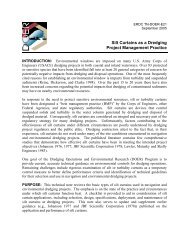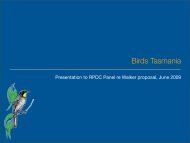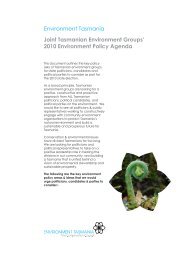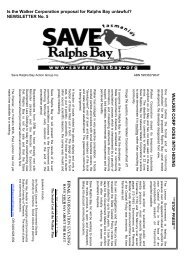Jane MacDonald - Save Ralphs Bay
Jane MacDonald - Save Ralphs Bay
Jane MacDonald - Save Ralphs Bay
You also want an ePaper? Increase the reach of your titles
YUMPU automatically turns print PDFs into web optimized ePapers that Google loves.
“development” might travel to the Opossum <strong>Bay</strong> MPA or even right around the coast to<br />
Frederick Henry <strong>Bay</strong>, home to spotted handfish and red handfish colonies outside the<br />
Derwent estuary.” It does not appear that CSIRO hydrological modelling has been taken<br />
into consideration.<br />
Has there been an inadvertent omission of “issues raised in written representations” or<br />
“issues addressed at the hearings”, in this section of the DIAR, before the “Panel assessment<br />
and findings” on the Spotted Handfish on page 88?<br />
4. Topics not mentioned in the draft recommendations<br />
4.1 Sea level rise<br />
I was surprised that the Panel did not consider sea level rise to be an issue of significance in<br />
the case of a decision regarding the construction of a housing subdivision in the sea.<br />
It is my belief that frivolous construction projects in the marine environment cannot<br />
possibly be consistent with the application of the Precautionary Principal. Reliance on any<br />
particular engineering standard for sea level rise reminds me of King Canute’s (alleged)<br />
confidence in his ability to command the waves to stay back.<br />
I request that the Panel gives further consideration to the seriousness of the risk of much<br />
higher than anticipated sea level rises, coupled with increasingly severe weather impacts.<br />
I would like to draw the Panel’s attention to matters raised in a number of extracts from the<br />
‘Climate Change Risks to Australia's Coasts’ report, released by the Australian Government<br />
Department of Climate Change on November 14. (Emphases added).<br />
KEY FINDINGS<br />
• Climate change risks in the coastal zone are large, increasing and in some areas will be felt<br />
in the near term. While these risks will unfold over time, there is a case to begin now with<br />
early national action to reduce current risks and avoid the building of new exposures.<br />
• Avoidance of future risk is the most cost‐effective adaptation response in most cases.<br />
Decisions on future development, particularly in areas highly exposed to the impacts of<br />
climate change, should not increase risk.<br />
• Natural ecosystems provide valuable ecosystem services and can buffer many of the<br />
risks associated with a changing climate in the coastal zone. Planning is needed to<br />
maximise system resilience, allow for ecosystem movement and make explicit decisions<br />
about tradeoffs.<br />
<strong>Jane</strong> <strong>MacDonald</strong>, submission on DIAR Page 13







